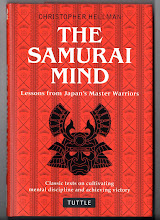 |
| Kano Tanyu: ceiling painting, Unryu, Myoshinji Temple, Kyoto |
Dragons have been depicted in Japan in a variety of different media, but the one that has produced some of the most powerful dragon art, reflecting the mysterious qualities of the dragon itself, is sumi-e. Viewing dragons can be a bit of a hit or miss affair - so here is a quick overview, with a few of the more notable artists' work.
Dragon imagery in Japan has a particularly close connection with Buddhism, particularly Zen, and the most striking images are often to be found in (or originally belonged to) Zen temples. These large scale works are typically found either on ceilings or on sliding doors or fusuma, and these two types of painting usually follow slightly different conventions in their depiction of dragons. A substantial number of hanging scrolls were also painted of dragons, and these tended to follow the same conventions as the fusuma-e.
In its connection with Buddhism, the symbolism exists on a number of levels - it was regarded as a protector of Buddhist law, and is often depicted on ceilings for this reason. Of course, they are closely associated with water, and it is said that a dragon can call up the clouds, and they are often painted as unryu or dragon in the clouds. It is a particular characteristic of fusuma-e dragons that their bodies are partly obscured by clouds - similarly, it is impossible for an initiate to fully grasp the nature of esoteric teachings (and of truth itself) without long, hard training, making them a powerful reminder of the depth and mystery of the traditions they represent.
Ceiling dragons, on the other hand, tend to be fully visible, painted within a circle, often on the bare boards of the ceiling, or with some accompanying clouds, often outside the circle. The body of the dragon remains unobscured. These dragons were painted in situ (in th egood old days, that is), the ink probably mixed with animal glue nikawa, making it possible to work upside down, and greatly increasing its permanency.
 |
| Kano Mitsunobu - Naki-ryu in Shokokuji Temple, Kyoto. |
The ceilings are also sometimes referred to as Happo nirami no ryu - or dragon glaring in 8 directions. This is a result of an effect similar to the well-known WWI recruitment poster of Kitchener (and Uncle Sam) pointing directly out of the picture at the viewer. In the case of dragons, this can prove even more dramatic as the direction of the dragon's coils appears to move as you walk around the hall.
 |
| A sketch of one of the 140 dragons |
There are also several modern versions – although they are testaments to the technical skill of the artists, I find them rather lacking in dragonish character, and painted a little too literally for my taste. Perhaps the mellowing influence of a few hundred years would change my mind.
Fusuma-e
The dragons painted on sliding doors are quite different in character from their counterparts on the ceilings – they show the inchoate elemental qualities of the dragon- large heads looming out of the mist, the coils of their bodies disappearing in the rain and clouds. They are unknowable denizens of a world we cannot understand; real unryu, and in many depictions, the clouds form a greater part of the work than the dragon. The subtlety of gradation and the dynamism of the swirling clouds makes sumi the perfect medium for these works, and the power of the best examples is undeniable.
 |
| Kaiho Yusho, Unryu, Kenninji Temple, Kyoto |
When mounted on screens, they are often paired with the tiger, but on sliding doors, they may cover all four walls of a room. Although the dragon’s head usually provides the focal point, the swirling clouds, crashing waves and the dark sky are also important elements in the composition. On some doors the dragon is not visible at all, or else there is just a clawed foot or a glimpse of a scaled back.
 |
| Kaiho Yusetsu (Yusho's son), Myoshinji Temple |
The other notable feature of these works that separates them from their foreign cousins is the face – with its bald head, hairy nostrils and buck teeth, the dragon is possessed of distinctly human features, and not always flattering ones at that. Whereas the western dragon has a lean predatory air, the Japanese dragon combines its wisdom with a knowledge of human weakness, giving some of these works an otherworldly and sometimes rather strange atmosphere. The works of the Kaiho school in particular are sometimes quite strange.
 |
| Maruyama Okyo - slightly later than the other works depicted here, but very impressive all the same. |
Ultimately, these dragon paintings still convey something quite special. The reason, I think, is that they combine elements of the schools of thought that deeply influenced the medium – sumi-e – and the qualities of the dragon itself. Daoism and Buddhism both seek or posit an explanation of the nature of the world. The development of ink painting is closely linked to these traditions, and something of their beliefs about the transmutability of energy and form became linked to this particular medium of artistic expression. The dragon itself also echoes the twisting, multiform flow of energy that can be seen at work in clouds, water, the growth of trees and the folds of mountains. It is the theme par-excellence of sumi-e, expressing in a visual form the pattern of our world.










